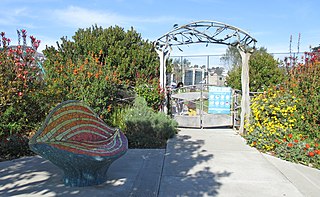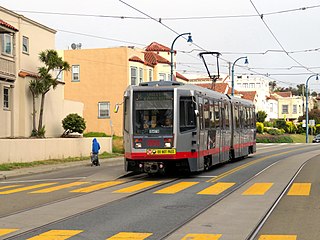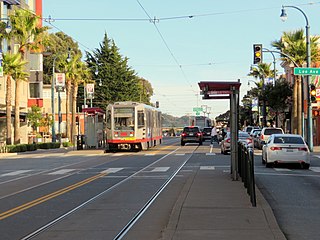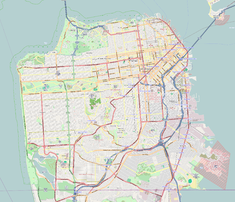
The Excelsior District is a neighborhood in San Francisco, California.

Balboa Park is a public park in the Mission Terrace neighborhood of San Francisco, California. It was originally dedicated in 1909 when the park included the land now used by City College of San Francisco Ocean Campus west of I-280 Freeway. The park is located in the Outer Mission neighborhood group, and is adjacent to the neighborhoods of Cayuga, Ingleside, Oceanview, and Sunnyside. The park covers about 25 acres and includes among its facilities: Balboa Park Swimming Pool, Balboa Park Playground, Matthew J. Boxer Stadium (soccer), Sweeney Field (baseball), Balboa Skate Park, an off-leash dog area, a picnic area, tennis courts, and a basketball court.

The San Francisco Public Library is the public library system of the city and county of San Francisco. The Main Library is located at Civic Center, at 100 Larkin Street. The library system has won several awards, such as Library Journal's Library of the Year award in 2018. The library is well-funded due to the city's dedicated Library Preservation Fund that was established by a 1994 ballot measure. The Preservation Fund was renewed twice, by ballot measures in 2007 and 2022.
Westwood Park is a residential neighborhood located in southwestern San Francisco, California, near St. Francis Wood and City College of San Francisco. Westwood Park is bordered by Monterey Boulevard, Ocean Avenue, Faxon Avenue, and Phelan Avenue now Frida Kahlo Way. Architecturally, the neighborhood contains a mix of smaller, more modest Craftsman style and Mediterranean style bungalows on a series of concentric oval-shaped streets. The ovals are bisected by Miramar Avenue, which features a landscaped median planted with a variety of trees. Many streets in this neighborhood have a suffix of "wood," such as Eastwood, Northwood, Wildwood, and so forth.

Thelton Eugene Henderson is an inactive senior United States district judge of the United States District Court for the Northern District of California. He has played an important role in the field of civil rights as a lawyer, educator, and jurist.
Cecil Francis Poole was a United States circuit judge of the United States Court of Appeals for the Ninth Circuit, a United States district judge of the United States District Court for the Northern District of California, and a United States Attorney for the Northern District of California. He was the first African American to serve as a United States Attorney, the first African American to serve as a Judge of the Northern District of California and the second African American to serve as a Judge of the Ninth Circuit.

Outer Mission is a small residential neighborhood on the south edge of San Francisco, bounded by Geneva Avenue, Interstate 280, Mission Street, and the city of Daly City. It is bordered by the Mission Terrace, Crocker-Amazon, and Ingleside, and touches Excelsior. The Muni streetcar historic "car barn" is at the northern corner of this neighborhood. Cayuga Park is located in this neighborhood. The Cayuga Improvement Association (CIA) covers the area bounded by Interstate 280, Mission Street, Sickles and Onondaga. Some folks have attempted to define "Cayuga Terrace" as a subset neighborhood of the larger Mission Terrace neighborhood, but maps show Geneva Avenue as the cutoff.

River Terrace is an urban cul-de-sac neighborhood in Northeast Washington, D.C., on the eastern bank of the Anacostia River. River Terrace is Washington, DC's only planned unit development that has an unimpeded connection to and relationship with the Anacostia River.

Ocean and San Leandro is a light rail stop on the Muni Metro K Ingleside line, located between the Balboa Terrace and Ingleside Terrace neighborhoods of San Francisco, California. It originally opened around 1896 on the United Railroads (12) line; K Ingleside service began in 1919. The stop consists of two side platforms, with the eastbound (outbound) platform located on Ocean Avenue west of the intersection with San Leandro Way, and vice versa.

Ocean and Aptos is a light rail stop on the Muni Metro K Ingleside line, located between the Balboa Terrace and Ingleside Terrace neighborhoods of San Francisco, California. The stop consists of two side platforms, with the eastbound (outbound) platform located on Ocean Avenue west of the intersection with Aptos Avenue, and vice versa. It originally opened around 1896 on the United Railroads 12 line; K Ingleside service began in 1919.

Ocean and Westgate (inbound) and Ocean and Cerritos (outbound) are a pair of one-way light rail stops on the Muni Metro K Ingleside line, located between the Mount Davidson and Ingleside Terrace neighborhoods of San Francisco, California. The stops consist of one side platform each, with the eastbound (outbound) platform located on Ocean Avenue west of the intersection with Westgate Drive and Cerritos Avenue, and vice versa. They originally opened around 1896 on the United Railroads 12 line; K Ingleside service began in 1919.

Ocean and Fairfield (inbound) and Ocean and Victoria (outbound) are a pair of one-way light rail stops on the Muni Metro K Ingleside line, located between the Mount Davidson and Ingleside Terrace neighborhoods of San Francisco, California. The stops consist of one side platform each, with the eastbound (outbound) platform located on Ocean Avenue west of the intersection with Victoria Street and the westbound (inbound) located east of the intersection and just west of Fairfield Way. They originally opened in 1895 on the United Railroads 12 line; K Ingleside service began in 1919.

Ocean and Dorado (inbound) and Ocean and Jules (outbound) are a pair of one-way light rail stops on the Muni Metro K Ingleside line, located between the Mount Davidson and Ingleside neighborhoods of San Francisco, California. The stops consist of one side platform each, with the eastbound (outbound) platform located on Ocean Avenue west of the intersection with Dorado Terrace and Jules Avenue, and the westbound (inbound) platform located east of the intersection. It originally opened in 1895 on the United Railroads 12 line; K Ingleside service began in 1919.

Ocean and Miramar is a light rail stop on the Muni Metro K Ingleside line, located between the Westwood Park and Ingleside neighborhoods of San Francisco, California. The stop consists of two side platforms, with the eastbound (outbound) platform located on Ocean Avenue west of the intersection with Miramar Avenue and the westbound (inbound) platform located east of the intersection. It originally opened in 1895 on the United Railroads 12 line; K Ingleside service began in 1919.

Ocean and Lee is a light rail stop on the Muni Metro K Ingleside line, located between the Westwood Park and Ingleside neighborhoods of San Francisco, California. The stop consists of two side platforms, with the eastbound (outbound) platform located on Ocean Avenue west of the intersection with Lee Street, and vice versa.

Ingleside Terraces is an affluent residential neighborhood of approximately 750 detached homes built at the former location of the Ingleside Racetrack in the southwestern part of San Francisco, California, United States. It is adjacent to the Balboa Terrace, Ingleside, Merced Heights and Lakeside neighborhoods, and is bordered by Ocean Avenue to the north, Ashton Avenue to the east, Holloway Avenue to the south and Junipero Serra Boulevard to the west. The main local event that occurs is the Annual Sundial Park Picnic, in which the local residents host bicycle, chariot, and wagon racing. There is a large sundial located on Entrada Court, surrounded by the oval-shaped Urbano Drive, which was once a horse race track. Ingleside Terraces is one of nine master-planned residence parks in San Francisco.
The San Francisco Residence Parks are located in the western neighborhoods of San Francisco. The first of the master-planned residence parks to be built on the West side of the city was Presidio Terrace in 1905. This was followed by St. Francis Wood, Sea Cliff, Lincoln Manor, West Clay Park, Forest Hill, Balboa Terrace, Ingleside Terraces, and Jordan Park.
African Americans in San Francisco, California, composed just under 6% of the city's total population as of 2019 U.S. Census Bureau estimates, down from 13.4% in 1970. There are about 55,000 people of full or partial black ancestry living within the city. The community began with workers and entrepreneurs of the California Gold Rush in the 19th century, and in the early-to-mid 20th century, grew to include migrant workers with origins in the Southern United States, who worked as railroad workers or service people at shipyards. In the mid-20th century, the African American community in the Fillmore District earned the neighborhood the nickname the "Harlem of the West," referring to New York City's Harlem neighborhood, which is associated with African American culture.

Ingleside Presbyterian Church is a historically African American church in the Ingleside neighborhood of San Francisco. The church is a San Francisco landmark and is noted for the collection of pictures and paintings that cover the interior walls as murals named The Great Cloud of Witnesses.

















